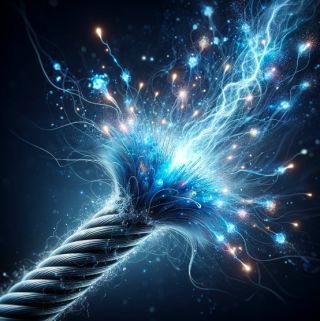Artificial Intelligence
The Rise of the Techno-Energy Complex
Will the vast energy demands of AI create another powerful alliance?
Posted May 3, 2024 Reviewed by Kaja Perina
Key points
- AI's growth demands massive energy, straining outdated power grids.
- Potential energy needs of AI are vast and hard to predict.
- This convergence poses societal risks and opportunities for innovation in energy and AI.

You know that feeling when two powerful forces collide? Like watching tectonic plates grind together, building up immense pressure until the surface splits and quakes? That's kind of what's happening with energy and technology right now.
Powering the Future: The Rise of the Techno-Energy Complex
On one side, you've got artificial intelligence (AI) rapidly becoming the new superpower. AI is no longer some sci-fi fantasy—it's a reality shaping everything from online shopping to health care to military defense. And this burgeoning intelligence needs massive amounts of computational power and electricity to keep running.
On the other side is the antiquated energy grid that's straining to meet the demands of the 21st century. Our power infrastructure is like that rusty, creaky bridge you hesitantly drive across while holding your breath. It was built for a different era, before smart homes, electric vehicles, and AI scientists crunching zettabytes of data.
The collision of these two titans—the insatiable hunger of AI for energy and the decrepit state of our power grids—is giving rise to what I'll dub the "techno-energy complex." An interwoven tangle of technology giants, utility companies, renewable developers, and firms working on power storage, transmission, generation and AI efficiency.
Thirst for Power: AI's Growing Energy Needs
One of the biggest unknowns around the techno-energy complex is just how incredibly thirsty AI will become for electricity. Current estimates are merely scratching the surface, as new AI models and applications emerge daily. From autonomous vehicles to smart cities to industrial automation, the potential use cases seem limitless. And as the technology becomes more advanced and ubiquitous, the energy demands may scale exponentially in unpredictable ways. But, we're dealing with a slippery variable that makes conducting reliable long-term forecasts for AI's utility needs akin to mapping the expansion of the universe. The only certainty is that our grids better be able to flex and evolve at a mind-bending pace.
Echoes of the Past: Shades of the Military-Industrial Complex
Further, and just as frightening, there are shades of the "military-industrial complex" that President Eisenhower warned about back in 1961. Just as the business of war became a vested interest, the techno-energy complex could exert an undue influence over society as we become more and more dependant on AI and desperate for unlimited electricity.
Investing in Tomorrow: Corporate Moves in Energy Innovation
Already, the major tech companies are making huge investments in energy projects from cutting-edge batteries to solar farms to nuclear plants. They need to power their AI ambitions while projecting an environmentally friendly image. Utility companies, feeling pressured by grid vulnerabilities, are looking to manage uncertainty by adopting strategies to stay ahead of the growing demand.
Dual-Edged Sword: Potential and Perils of the Techno-Energy Nexus
At its best, the techno-energy complex could spark breakthroughs in nuclear power, renewable power, efficient computing, smart grid management and more sustainable living. At its worst, it's a privatized cabal or a functional monopoly cabal consolidating control over the digital brains and power arteries of our civilization.
A Call to Power: Navigating the New Landscape
This convergence of AI and energy represents a critical juncture that society can neither ignore nor circumvent. The field of AI is progressing at an exponential rate, catalyzed by significant computational demands that will only continue to intensify. Concurrently, global energy consumption rises unabated, driven by industrialization, population growth, and the proliferation of technology into every facet of modern life.
As these two indispensable pillars—the fuel of innovation and the innovation of fuel—become further intertwined, we are entering a period of transformation fraught with complexities. Navigating the obstacles and ramifications of this techno-energy nexus will prove an immense challenge testing our technological capabilities, ethical frameworks, and environmental resilience.
The convergence of AI and energy has set powerful forces into motion on a collision course. Institutions, governments, and individuals would be prudent to meticulously study this critical shift and prepare for the uncharted landscapes that lie ahead. A new age of disruption has arrived—to ignore its momentum would be imprudent and fly in the face of transformative technological progress.
References
James Vincent. How much electricity does AI consume? The Verge. February 16, 2024.
Lauren Leffer. The AI Boom Could Use a Shocking Amount of Electricity. Scientific American. October 13, 2023.
Amazon buys nuclear-powered data center from Talen. Nuclear Newswire. March 7, 2024.
Alfonso Encinas Fernandez, Blake Houghton, Adam Rubin, and Aaron Schifrin. Grid planning under uncertainty: Investing for the energy transition. McKinsey and Company. December 5, 2023.




